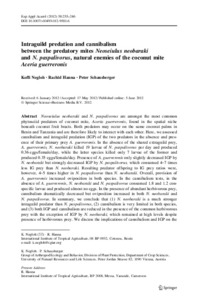| dc.contributor.author | Negloh, K. |
| dc.contributor.author | Hanna, R. |
| dc.contributor.author | Schausberger, P. |
| dc.date.accessioned | 2019-12-04T11:08:22Z |
| dc.date.available | 2019-12-04T11:08:22Z |
| dc.date.issued | 2012-11 |
| dc.identifier.citation | Negloh, K., Hanna, R. & Schausberger, P. (2012). Intraguild predation and cannibalism between the predatory mites Neoseiulus neobaraki and N. paspalivorus, natural enemies of the coconut mite Aceria guerreronis. Experimental and Applied Acarology, 58(3), 235-246. |
| dc.identifier.issn | 0168-8162 |
| dc.identifier.uri | https://hdl.handle.net/20.500.12478/1805 |
| dc.description.abstract | Neoseiulus neobaraki and N. paspalivorus are amongst the most common phytoseiid predators of coconut mite, Aceria guerreronis, found in the spatial niche beneath coconut fruit bracts. Both predators may occur on the same coconut palms in Benin and Tanzania and are therefore likely to interact with each other. Here, we assessed cannibalism and intraguild predation (IGP) of the two predators in the absence and presence of their primary prey A. guerreronis. In the absence of the shared extraguild prey, A. guerreronis, N. neobaraki killed 19 larvae of N. paspalivorus per day and produced 0.36 eggs/female/day, while the latter species killed only 7 larvae of the former and produced 0.35 eggs/female/day. Presence of A. guerreronis only slightly decreased IGP by N. neobaraki but strongly decreased IGP by N. paspalivorus, which consumed 4–7 times less IG prey than N. neobaraki. Resulting predator offspring to IG prey ratios were, however, 4–5 times higher in N. paspalivorus than N. neobaraki. Overall, provision of A. guerreronis increased oviposition in both species. In the cannibalism tests, in the absence of A. guerreronis, N. neobaraki and N. paspalivorus consumed 1.8 and 1.2 conspecific larvae and produced almost no eggs. In the presence of abundant herbivorous prey, cannibalism dramatically decreased but oviposition increased in both N. neobaraki and N. paspalivorus. In summary, we conclude that (1) N. neobaraki is a much stronger intraguild predator than N. paspalivorus, (2) cannibalism is very limited in both species, and (3) both IGP and cannibalism are reduced in the presence of the common herbivorous prey with the exception of IGP by N. neobaraki, which remained at high levels despite presence of herbivorous prey. We discuss the implications of cannibalism and IGP on the population dynamics of A. guerreronis and the predators in view of their geographic and within-palm distribution patterns. |
| dc.description.sponsorship | Government of Austria |
| dc.format.extent | 235-246 |
| dc.language.iso | en |
| dc.subject | Trophic Interactions |
| dc.subject | Eriophyidae |
| dc.subject | Phytoseiidae |
| dc.subject | Biological Control |
| dc.subject | Coconut |
| dc.title | Intraguild predation and cannibalism between the predatory mites Neoseiulus neobaraki and N. paspalivorus, natural enemies of the coconut mite Aceria guerreronis |
| dc.type | Journal Article |
| dc.description.version | Peer Review |
| cg.contributor.crp | Integrated Systems for the Humid Tropics |
| cg.contributor.affiliation | University of Natural Resources and Life Sciences, Austria |
| cg.contributor.affiliation | International Institute of Tropical Agriculture |
| cg.coverage.region | Africa |
| cg.coverage.region | West Africa |
| cg.coverage.region | East Africa |
| cg.coverage.country | Benin |
| cg.coverage.country | Tanzania |
| cg.isijournal | ISI Journal |
| cg.authorship.types | CGIAR and advanced research institute |
| cg.iitasubject | Pests Of Plants |
| cg.journal | Experimental and Applied Acarology |
| cg.howpublished | Formally Published |
| cg.accessibilitystatus | Limited Access |
| local.dspaceid | 83257 |
| cg.identifier.doi | http://dx.doi.org/10.1007/s10493-012-9581-6 |

